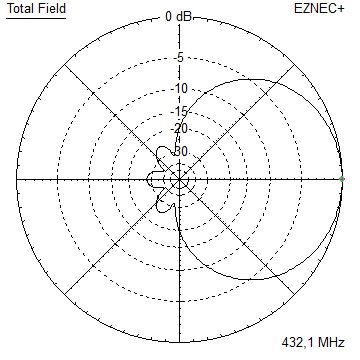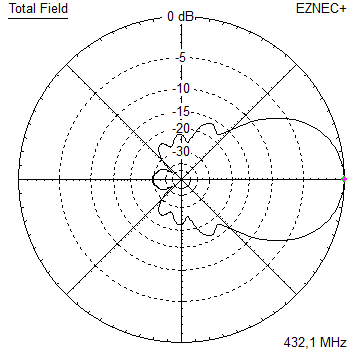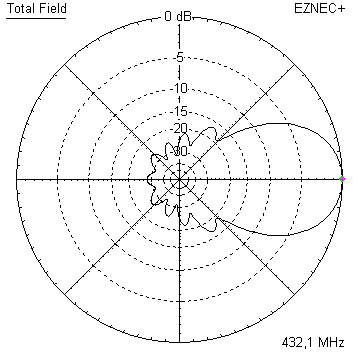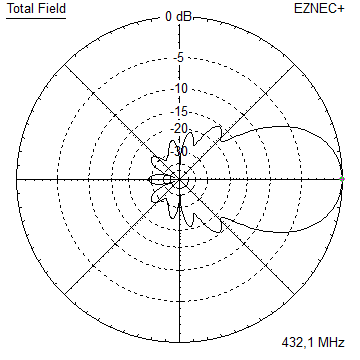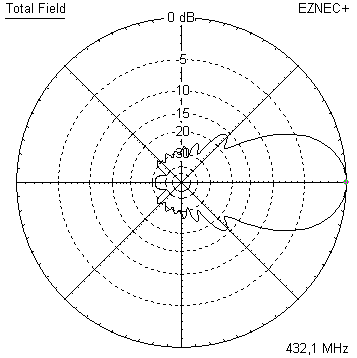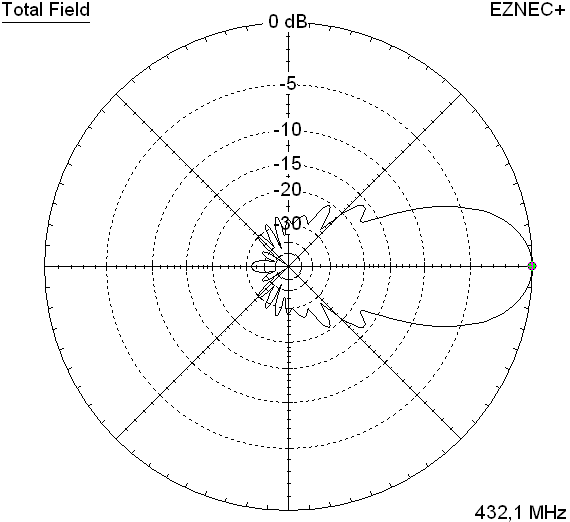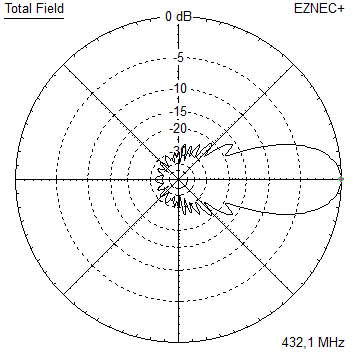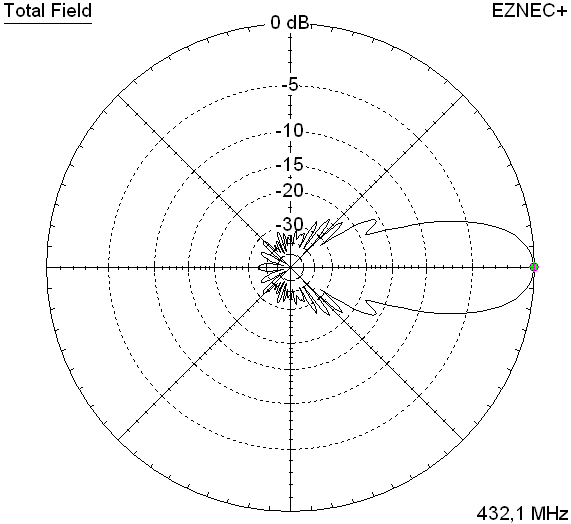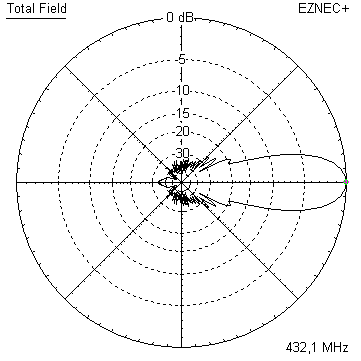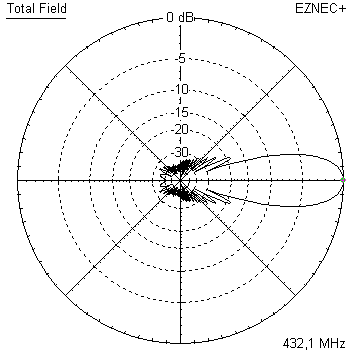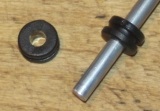
GTV 70-7w Yagi with bent Driven Element
Wideband version ... 430 to 438 (440) MHz
This Yagi has very low back lobes for its length and bandwidth.
Simulated Return Loss (S11) is better -30 dB from 430 to 438 MHz. It may serve as single antenna for portable
use and is easy to repoduce. It certainly makes a useful 4 x vertical stack. It makes a quiet contest antenna due to its
high F/B. The bent DE (K6STI style) transforms from approx. 17 ohms to 50 ohms at feed point. Design date: May 2019.
This designs origin is the YBN 3+7 SAT handheld combination Yagi.
With M0ABA having built it the first thing he did was a moon bounce test,
which went well with only 60 W at the feedpoint.
See building details and screenshots of the EME QSO on the SAT Yagis website
GTV70-7w portable version built by Thomas, M0ABA
This Yagi is built on a boom 5/8 inch with elements 4.0 mm held in place with insulators by 7arrays

GTV70-7w built by Thomas, M0ABA

GTV70-7w built by Wolf, DF7KB
This Yagi is built on a boom 25 x 25 x 2 mm with elements 4.0 mm held in place with insulators by 7arrays


Current distribution

3D Pattern (432.1 MHz)
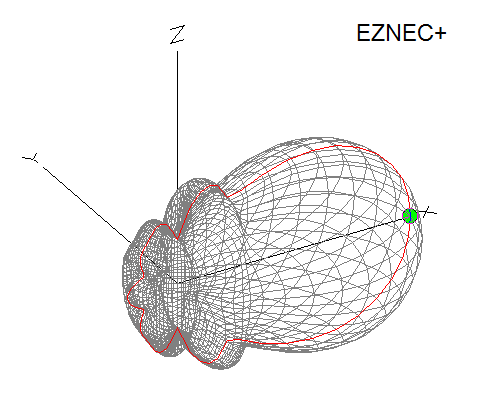
Performance Data
Specs: with 6.35 mm elements @ 432.1 MHz
Gain vs. isotr. Rad. 12.3 dBi Gain vs. Dipole 10.1 dBD -3 dB E-plane 44.3 deg. -3 dB H-plane 52.2 deg. F/B -26.5 dB F/R -21.5 dB Impedance 50 ohms Mechan. Length 960 mm incl. 2 x 30 mm stand off Electr. Length 1.30 λ Stacking dist. h-pol. top-to-bottom 0.79 m or 2.59 ft side-by-side 0.92 m or 3.02 ft
How many OMs have been looking up this design?
Geometry

Table 1: 70 cm section, 6.35 mm elements through a 5/8 inch boom,
formast mount with 280 mm offset on rear boom end:
"Ready to saw and drill" data for mounting elements through boom with BC according SM5BSZ's BC.exe:
|
This table is only valid for: Boom shape: square Boom dim: 5/8 x 5/8 inch Wall thickn.: 1/6 inch = 1.6 mm Holes in boom: 8.0 mm Offset rear: 280 mm Offset front: 30 mm |
|
Note: This does include an SBC of 1.74 mm plus a correction for the insulators (v-factor!) of 0.7 mm = 2.44 mm
Note: with through Boom BC it is important to stick to the boom end offsets given below!

Table 1: 70 cm section, 4.00 mm elements through a 20 x 20 mm boom,
formast mount with 280 mm offset on rear boom end:
"Ready to saw and drill" data for mounting elements through boom with BC according SM5BSZ's BC.exe:
|
This table is only valid for: Boom shape: square Boom dim: 20 x 20 mm Wall thickn.: 2.0 mm Holes in boom: 6.0 mm Offset rear: 280 mm Offset front: 40 mm |
|
Note: This does include an SBC of 1.74 mm plus a correction for the insulators (v-factor!) of 0.7 mm = 2.44 mm
Note: with through Boom BC it is important to stick to the boom end offsets given below!

Table 1: 70 cm section, 4.00 mm elements through a 5/8 inch boom,
formast mount with 280 mm offset on rear boom end:
"Ready to saw and drill" data for mounting elements through boom with BC according SM5BSZ's BC.exe:
|
This table is only valid for: Boom shape: square Boom dim: 5/8 x 5/8 inch Wall thickn.: 1/6 inch = 1.6 mm Holes in boom: 6.0 mm Offset rear: 280 mm Offset front: 40 mm |
|
Note: This does include an SBC of 1.74 mm plus a correction for the insulators (v-factor!) of 0.7 mm = 2.44 mm
Note: with through Boom BC it is important to stick to the boom end offsets given below!

For making of a 'Blade Dipole'
Sketch of Bent Dipole

Radiation Pattern and VSWR Plots
Elevation and Azimuth plot at 432.1 MHz (6.35 mm ele.)


SWR and Return Loss plots - simulated with 4nec2

M0ABA plotted Return Loss 70 cm: -44 dB at 435.5 MHz
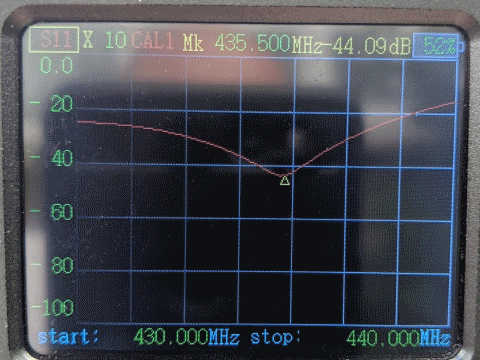

Elevation Pattern 430 - 438 MHz


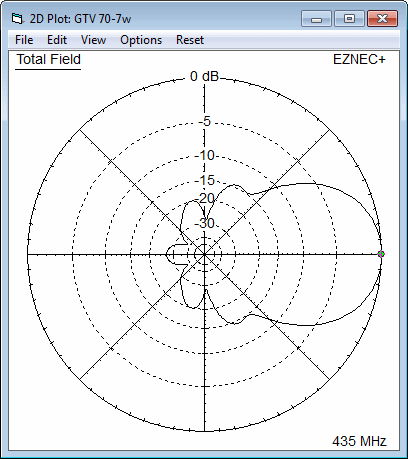

xpol Details

Offset between h and v-plane is 270 mm
xpol Table 1: 70 cm section, 4.00 mm elements through a 15 x 15 mm boom,
formast mount with 340 mm offset on rear boom end:
"Ready to saw and drill" data for mounting elements through boom with BC according SM5BSZ's BC.exe:
|
This table is only valid for: Boom shape: square Boom dim: 15 x 15 mm Wall thickn.: 2.0mm Holes in boom: 6.0 mm Offset h-plane rear: 340 mm Offset h-plane front: 310 mm Offset v-plane rear: 610 mm Offset v-plane front: 40 mm |
|
Note: This does include an SBC of 1.281.74 mm plus a correction for the insulators (v-factor!) of 0.7 mm
for compensation of the insulators (7arrays.com
Note: with through Boom BC it is important to stick to the boom end offsets given below!

Downloads
none so far
Stacking
Stacking Dist. DL6WU Formula H-plane 0.79 m E-plane 0.96 m
A 4 Yagi bay
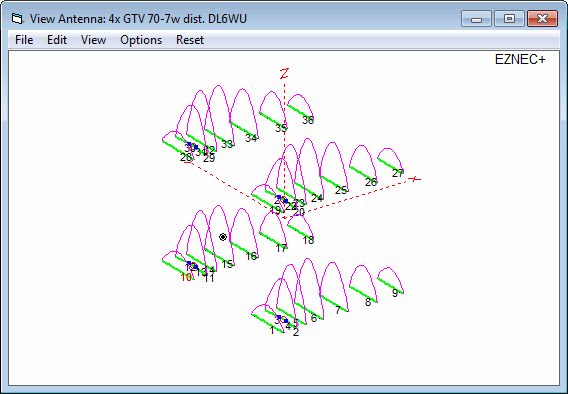
Elev. and Az. Plot @ 432.3 MHz


Data for elements 6.35 mm @ 432.3 MHz
Gain vs. isotr. Rad. 18.25 dBi Gain vs. Dipole 16.10 dBD -3 dB H-plane, appr. 19.8 deg. -3 dB E-plane, appr. 23.2 deg. F/B -29.4 dB F/R -23.9 dB T_ant 140.1 K* G/T -3.21 dB*Theoretical numbers, no phasing line losses
nor imperfections caused by mast included
*) T_sky = 27 K, T_earth = 1800 K as in newer VE7BQH G/T table
3D pattern plot with 4nec2's 3D viewer


4 x vertical Stack at 770 mm each


8 x vertical Stack at 770 mm each
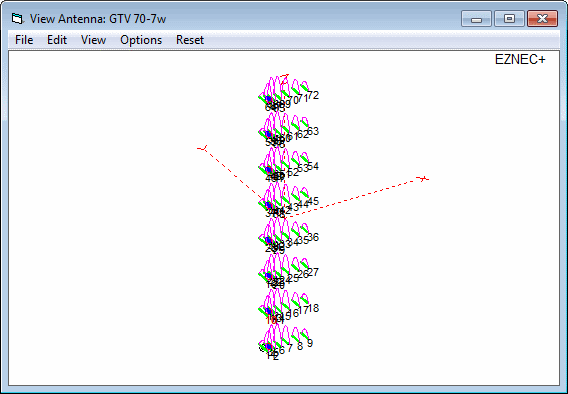

Symmetrising 50 to 50 ohms feedline to 432 MHz Bent DE
The principle is similar to the 1/4 Lambda coax. Adding 2 x 1/4 Lambda or a half wave line does not change anything but allows
to form a gentle bow below the boom or until behind the Reflector. Follow practical construction hints on "Building a Yagi" page.


 Attenzione!
Take care when lengthening the coax, measure the actual electrical length instead of considering v-factors specified in a catalogue only.
Attenzione!
Take care when lengthening the coax, measure the actual electrical length instead of considering v-factors specified in a catalogue only.A good choice may be the diam. 5 mm PTFE coax RG-142 B/U: real resonate length (432.2 MHz as 3/4 Lambda) shield-shield is around 348 mm
 Find more information on Phasing & Matching Lines page
Find more information on Phasing & Matching Lines page 73, Hartmut, DG7YBN






